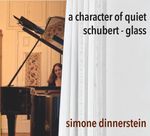|
Back
09/23/2020
“A Character of Quiet”
Philip Glass: Etude n° 16 – Etude n° 6 – Etude n° 2
Franz Schubert: Piano Sonata in B-Flat major, D. 960
Simone Dinnerstein (piano)
Recording: Home of Simone Dinnerstein, Brooklyn, New York (June 22-23, 2020) – 70’24
Orange Mountain Music #0147 (Distributed by PIAS)

   
Benjamin Britten once called the period between Beethoven’s death in 1827 and Schubert’s in 1828 the “richest and most productive eighteen months in our music history.” He was referring to Schubert’s final body of work, a frenzied period of swan songs (equaled only by Mozart’s) yielding some of the most memorable works of the Western musical canon.
One of the greatest of these is the Sonata in B-Flat major for Piano, D.960, an Everest fraught with pitfalls and studded with starlight for each pianist to conquer on his or her own. Today, after nearly 200 years of performance by leading pianists, the trick is to find a new way of delivering Schubert’s final piano sonata that is fresh yet authoritative.
Just such a performance is tendered by the American pianist Simone Dinnerstein who recorded this work, along with three etudes by Philip Glass, in her New York apartment during the 2020 pandemic. Like most of us, Dinnerstein was blindsided by a reality defined by lockdowns and quarantines, a world where arts performance came crashing to a halt, and artists and audiences alike wrestled with a mandate to stay home and stay well. It was not an atmosphere to inspire creativity. After several months of realizing the problem was not going to disappear on its own, Dinnerstein resumed practicing in earnest. With the help of her longtime friend and producer, Adam Abeshouse, she recorded this album in her home in just two days.
Dinnerstein is quite a remarkable figure in the world of classical piano performance. She never made a splash in the world of piano competitions, dropped out of Juilliard, took private lessons in London, fell in love, got married and had a baby. Most extraordinarily, she hasn’t tried to change her innate musical vision and mold herself to the dictates of the musical establishment. Her sound is unique, and not to everyone’s liking. (It is to mine.) And with Dinnerstein, that is perfectly OK. She would rather play her way, in her style, than try to change into someone she is not.
However, success sometimes comes to those who follow an unorthodox path. Less than 15 years ago, Dinnerstein developed a patron base to help her record and perform Bach’s Goldberg Variations. An impressed critic pitched her recording to a major record label, and a star was born.
Not unexpectedly, Dinnerstein brings to Schubert some of those same qualities that stood out in the Goldberg Variations. There is a tender, creamy texture to her playing, but one that snags the pulse of each of the four movements and won’t let go. Her touch is sure, but responsive to the music’s voice, as though to a living soul. Respecting the inner connectivity of the four movements, she brings out the lyricism of Schubert’s signature song-like themes. At the same time, she embraces the long passages of repeated sixteenth notes or triplets that seem to point ahead to a more mechanical, less romantic future.
Heard subjectively, these repetitions range from meditative waves to flickers of anxiety, but Schubert cuts them off at exactly the right moment to introduce some new effect we could not have imagined. For example, in in measures 428 and 429 of the last movement, the composer imposes a stunning two-bar silence followed by a bold fortissimo that, under Dinnerstein’s touch, takes one’s breath away.
Repetition is the hallmark of another composer featured on this album. Etudes n°16, n° 6, and n° 2 by Philip Glass offer a modern form of lyricism, in which rhythmic evenness and slight but peculiar shifts of harmony or tonal emphasis create engaging patterns of sound. It’s almost as though Glass uses a soft sable brush to paint each work, making him less the stuffy piano pedagogue and more the presider at a Zen tea ceremony.
Glass’s delightful musical perambulations are ideal for Dinnerstein’s sensibility of introspection, mingled with a keen engagement with the sensual world. In Etude n° 16, premiered in 2012, the pianist begins with a flowing 7/8 rhythm through a pasture of shadows and patches of sunlight. Etude n° 6 is more spritely, but Dinnerstein eschews any hint of playfulness or sport. She delineates Glass’s musical thought with clarity and respect. Most attractive, I found, was Etude n° 2 with its hushed veil of holiness and sounds that recall, but do not imitate, Nature.
For those who share Dinnerstein’s personal approach to music, “A Character of Quiet” is a gift to cherish, in difficult times or any time at all.
Linda Holt
|